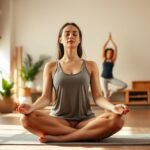Did you know 44% of Americans feel more stressed lately? Yoga is a great way to find calm and boost flexibility. This guide is for yoga newbies who want to feel better without complicated moves.
Simple yoga poses are a gentle way to fight stress and improve flexibility. They’re perfect for anyone dealing with tension or wanting to relax. This guide will show you easy, effective moves to boost your health.
Yoga is for everyone, even if you’re not fit or have no experience. You can start with basic poses that help you get stronger, more flexible, and clear-minded. Our goal is to make yoga fun and life-changing for beginners.
Key Takeaways
- Yoga is accessible to everyone, regardless of fitness level
- Simple poses can significantly reduce stress and improve flexibility
- No special equipment is required to begin practicing
- Consistent practice leads to physical and mental benefits
- Beginners can safely learn yoga at their own pace
Understanding the Basics of Beginner Yoga Practice
Starting a yoga journey can change your life. It’s a gentle way to get healthier, combining easy workouts with relaxation. Anyone can learn these simple techniques.
You don’t need to be flexible or have special skills to start yoga. It’s about making a practice that helps your body and mind. You’ll do gentle stretches and move with purpose.
Benefits of Starting a Yoga Journey
Yoga offers many benefits for beginners:
- Reduces stress and anxiety
- Improves overall flexibility
- Builds core strength
- Enhances mental clarity
- Boosts immune system function
“Yoga is not about touching your toes, it’s about what you learn on the way down.” – Jigar Gor
Essential Equipment for Beginner Yoga
You don’t need to spend a lot to start yoga. A few basic items can make your practice comfortable:
- Yoga mat
- Comfortable, stretchy clothing
- Water bottle
- Optional yoga blocks or straps
Creating Your Yoga Space
Make a peaceful area for your yoga. Choose a quiet spot with natural light. It should be inviting and calm. This will help you stay on track with your workouts.
Simple Yoga Poses for Beginners: Improve Flexibility & Reduce Stress

Starting yoga can change your life. It helps with both body and mind. Simple poses are great for beginners, teaching them to relax and stretch.
Here are some key poses for newbies:
- Child’s Pose (Balasana): A restorative pose that stretches the back and promotes deep relaxation
- Mountain Pose (Tadasana): Builds body awareness and improves posture
- Cat-Cow Stretch: Enhances spine flexibility and releases tension
Beginners can start with gentle stretches. These help build strength and calm the mind. It’s important to breathe right and align your body.
“Yoga is not about perfect poses, but about connecting with your body and breath.” – Yoga Instructor Wisdom
Begin with 10-15 minutes of yoga each day. Pay attention to your body and move slowly. Yoga is a journey of self-discovery and healing.
Preparing Your Mind and Body for Yoga Practice
Starting a yoga journey is more than just moving your body. It’s about mental and physical readiness. Connecting your mind, body, and breath is key to a good yoga experience.
Proper Breathing Techniques
Breathing is vital in yoga for stress relief. Learning simple breathing methods can calm your nerves and boost mindfulness.
- Diaphragmatic breathing: Promotes deep relaxation
- Alternate nostril breathing: Balances energy and reduces anxiety
- Box breathing: Helps manage stress and improve focus
Basic Mindfulness Exercises
Yoga routines include mindfulness to keep you present. These exercises can clear your mind and boost your well-being.
- Body scan meditation
- Mindful observation
- Seated awareness practice
Setting Your Intentions
Yoga becomes more than just exercise when you have a purpose. It becomes a journey of self-discovery.
| Intention Type | Purpose | Practice Focus |
|---|---|---|
| Physical | Improve flexibility | Gentle stretching |
| Mental | Reduce stress | Breathing techniques |
| Spiritual | Inner peace | Meditation |
Remember, your yoga practice is a personal journey. Approach it with patience, curiosity, and compassion.
Foundation Poses for Building Strength and Balance
Starting a wellness journey with gentle yoga means learning key poses. These poses help build core strength and balance. They are essential for beginners to feel stable and confident in their practice.
Yoga enthusiasts can boost their self-care by mastering these foundational poses:
- Mountain Pose (Tadasana): Develops body awareness and alignment
- Warrior II (Virabhadrasana II): Strengthens legs and improves balance
- Tree Pose (Vrksasana): Builds single-leg stability
- Plank Pose: Develops core and upper body strength
Each pose targets different muscles and helps focus the mind. Beginners should be patient, knowing strength grows slowly.
“Yoga is not about touching your toes, but what you learn on the way down.” – Jigar Gor
Here’s a guide to track your progress in strength and balance:
| Pose | Primary Muscle Groups | Balance Difficulty |
|---|---|---|
| Mountain Pose | Legs, Core | Low |
| Warrior II | Quadriceps, Shoulders | Medium |
| Tree Pose | Ankles, Stabilizers | High |
| Plank Pose | Core, Arms, Shoulders | Medium |
Remember, consistent practice is key to developing strength and balance in your yoga journey.
Gentle Stretching Sequences for Enhanced Flexibility
Starting gentle yoga routines can change your life. It’s not about being perfect but about caring for your body. These stretches will help you relax and move better.
Getting flexible takes time and learning about yourself. Yoga stretches help you relax, move more freely, and feel your body’s rhythm.
Upper Body Stretches
Being flexible in your upper body helps your muscles relax and keeps your posture right. Try these simple moves:
- Shoulder rolls to release neck and shoulder tension
- Eagle arms to open shoulder blades
- Gentle chest openers to improve breathing
Lower Body Flexibility Poses
Stretches for your lower body keep your joints healthy and prevent stiffness. Focus on these areas:
- Seated forward bends for hamstring flexibility
- Gentle hip openers to release stored tension
- Ankle and calf stretches to improve mobility
Spine-Lengthening Movements
A flexible spine is key for your body’s health. These gentle moves can help:
- Cat-cow pose for spinal mobility
- Gentle twists to release back tension
- Child’s pose for complete spinal relaxation
Remember, your yoga is for you. Listen to your body, breathe deeply, and welcome each stretch with kindness and awareness.
Stress-Relief Poses for Mental Wellbeing
Yoga is a great way to manage stress and improve mental health. It offers gentle yoga for stress reduction. This helps create a calm space in your daily life.
Stress-relief yoga focuses on mindful movement and breath. These practices calm your nervous system and clear your mind. Yoga breathing exercises can change your mental state and bring peace.
- Child’s Pose: A restorative position that promotes deep relaxation
- Forward Fold: Releases tension in the back and calms the mind
- Legs-Up-The-Wall Pose: Reduces anxiety and promotes circulation
Success in stress reduction through yoga comes from gentle stretching and regular practice. Each pose is a meditation, helping you let go of external pressures and connect with yourself.
| Pose | Stress-Relief Benefits | Duration |
|---|---|---|
| Child’s Pose | Calms nervous system | 3-5 minutes |
| Forward Fold | Releases back tension | 2-3 minutes |
| Legs-Up-The-Wall | Reduces anxiety | 5-7 minutes |
Your yoga practice is unique. Listen to your body and breathe deeply. Approach each pose with kindness. Regular practice makes these techniques powerful for mental wellbeing.
Creating a Daily Yoga Routine for Beginners
Starting a yoga practice can change your life for the better. You don’t need to spend hours or do complicated moves. Even simple yoga can help your body and mind.
Finding a yoga practice that fits your life is key. Beginners often find it hard to manage time. But, yoga can easily fit into your day with the right mindset.
Morning Practice Guidelines
Start your day with gentle yoga stretches. These can energize and prepare you. A 10-15 minute morning routine can greatly improve your well-being.
- Wake up 15 minutes earlier
- Choose 3-5 simple stretching poses
- Focus on breathing and mindful movement
Evening Relaxation Sequences
End your day with calming yoga to release stress. Evening yoga can also help you sleep better and think clearer.
| Evening Pose | Duration | Benefit |
|---|---|---|
| Child’s Pose | 3-5 minutes | Stress Relief |
| Legs-Up-The-Wall | 5-7 minutes | Circulation |
| Seated Forward Bend | 3-4 minutes | Spine Flexibility |
Time Management Tips
Adding yoga to a busy schedule needs strategic planning. Start small and stick to it. Even a 10-minute practice can be very beneficial.
- Schedule yoga like any important appointment
- Prepare yoga space the night before
- Use mobile apps for guided sessions
- Be flexible with practice times
Common Mistakes to Avoid in Beginner Yoga
Starting yoga can be both thrilling and tough for newbies. Many beginners make mistakes that slow down their progress. Knowing these common errors can help you practice yoga safely and effectively.
- Pushing Too Hard: Beginners often think being intense means they’re getting better. But gentle stretches should feel good, not hurt. Always listen to your body and respect its limits.
- Comparing Yourself to Others: Everyone’s yoga journey is different. Your goal is to get better at your own pace, not compete with others.
- Neglecting Proper Alignment: Wrong poses can hurt you. Focus on doing poses right, even if it’s simpler.
Getting your alignment right in yoga is key. Many people rush through poses or try hard moves too soon. Take time to learn the basics of each pose.
Yoga is a personal journey of self-discovery and physical awareness. Progress comes from patience, not perfection.
Breathing right is also important in yoga. Bad breathing can mess up your practice and stop you from getting the most out of yoga. Learn to breathe with your movements for a better experience.
- Start with beginner-level classes
- Use props for support
- Practice mindful, slow movements
- Prioritize quality over quantity
Remember, every expert was once a beginner. Your yoga journey is about growing, being kind to yourself, and getting better slowly. Enjoy the learning and your path to better health.
Progressing Your Practice Safely
Starting your yoga journey is exciting. It’s a path of growth and self-discovery. Learning to progress safely is key for a long-term practice.
Your yoga routine is about steady, mindful growth. Everyone’s journey is different, with unique milestones and challenges.
Recognizing Your Progress
Tracking your yoga progress is more than just physical. Look for these signs:
- Increased flexibility and range of motion
- Improved breathing control
- Enhanced mental clarity
- Reduced stress levels
- Better body awareness
Challenging Yourself Wisely
Yoga growth comes from gentle challenges. Follow these guidelines for safe progression:
- Start with modifications of challenging poses
- Gradually increase hold times
- Experiment with slight variations
- Listen to your body’s signals
Body Awareness and Limits
“Your body is your greatest teacher in yoga. Respect its wisdom and boundaries.”
Knowing your limits prevents injury and promotes steady stress relief. Pay attention to:
- Sensations of discomfort vs. pain
- Breath quality during practice
- Energy levels before and after sessions
Enjoy your unique yoga journey with patience and compassion.
| Progress Indicator | Physical Sign | Mental Sign |
|---|---|---|
| Beginner Stage | Limited flexibility | High mental resistance |
| Intermediate Stage | Increased flexibility | Growing mental calm |
| Advanced Stage | Enhanced muscle control | Deep mental resilience |
Remember, yoga is a personal exploration. Progress at your own pace and celebrate each small achievement.
Integrating Mindfulness with Physical Practice
Yoga connects your mind and body, turning a simple workout into a powerful mindfulness practice. Beginner yoga poses do more than just move your body. They help you develop deep awareness and relaxation.
To add mindfulness to gentle stretching, focus on your breath and body feelings. Start by learning these important techniques:
- Breathe consciously during each pose
- Notice physical sensations without judgment
- Maintain awareness of your body’s alignment
- Practice non-reactive observation
Mindfulness in yoga reduces stress by keeping you in the present. Each breath connects physical movement with mental calm. This way, you learn more about your body’s strengths and limits.
“Yoga is the journey of the self, through the self, to the self.” – The Bhagavad Gita
Regular yoga practice boosts mental clarity and emotional strength. Seeing yoga as a whole experience lets you grow personally through simple stretches.
Remember, mindfulness takes time to learn. Be patient as you practice linking breath, movement, and awareness in your yoga.
Conclusion
Yoga is more than just exercise. It’s a way to improve your well-being and manage stress. Each pose you learn helps you find balance in body and mind.
Yoga isn’t just about moving your body. It connects your body, breath, and mind. The relaxation methods you’ve learned can help you face daily challenges calmly. It’s about growing your potential, not just stretching.
Remember, yoga progress is slow. It’s important to be patient and kind to yourself. Every small step counts. Whether you practice for a few minutes or an hour, you’re caring for your health.
Begin your yoga journey today. Listen to your body, breathe deeply, and open your heart. Your path to wellness starts with a single breath and a stretch.
FAQ
Do I need to be flexible to start yoga?
No, you don’t need to be flexible to start yoga. It’s for everyone, no matter your current flexibility. Yoga helps improve flexibility over time. Beginners can use blocks or straps to make poses easier.
The most important thing is to listen to your body and go at your own pace.
How often should I practice yoga as a beginner?
Start with 2-3 sessions a week, each lasting 15-30 minutes. It’s better to be consistent than to practice for a long time. Short, regular practices can help you build strength and reduce stress.
As you get more comfortable, you can practice more often and for longer.
What equipment do I need to start practicing yoga?
You only need a good yoga mat to start. Blocks, straps, and blankets can be helpful, but they’re not necessary. Wear comfy, stretchy clothes and practice in a quiet, spacious area.
Can yoga help with stress and anxiety?
Yes, yoga is great for managing stress and anxiety. It combines mindful movement, deep breathing, and meditation to calm your nervous system. Many people find yoga improves their mental health.
I have a health condition. Is yoga safe for me?
Always talk to your doctor before starting any new exercise. Many people with health conditions can benefit from yoga, but you might need to make some changes. A good yoga teacher can help you adapt poses to fit your needs.
How long does it take to see results from yoga?
Results vary, but many feel better right away. You might notice physical changes in 4-8 weeks if you practice regularly. Yoga is a personal journey, so focus on how you feel, not what others do.
Do I need to be able to do advanced poses to get benefits?
No, you don’t need to do advanced poses to get benefits. Simple poses can be very helpful. Advanced poses come with time and practice. The most important thing is to move mindfully and listen to your body.
Can I practice yoga at home as a beginner?
Yes, you can practice yoga at home as a beginner. Online classes, yoga apps, and YouTube tutorials are great resources. Start with beginner-friendly videos that show you how to do poses. As you get more comfortable, you might want to try in-person classes for more guidance.








